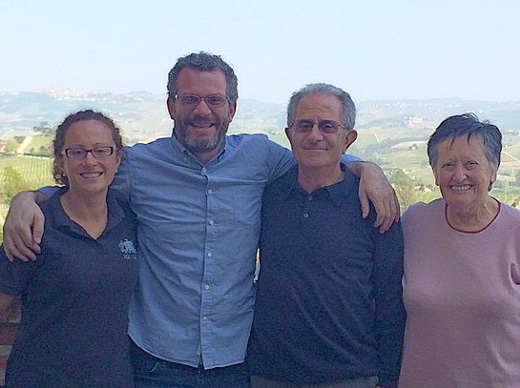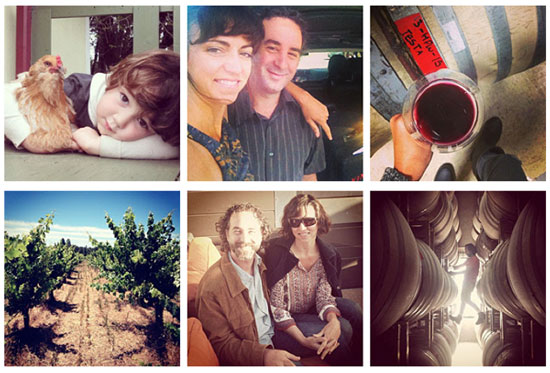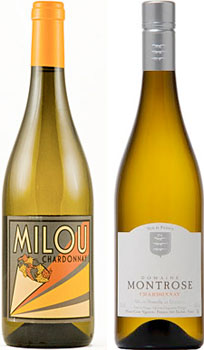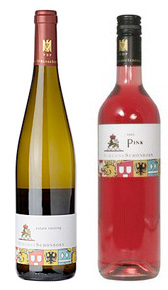| August 2014 | ||
| « Jul 2014 | News | Sep 2014 » |
August 25, 2014
FEATURED: Fire Drinkers of Campania
The history of eruptions in the Campanian volcanic arc have laid the groundwork for some of the most exquisite whites coming out of Italy today—it’s no wonder that ancient wine-loving Romans worshipped Vesuvius as a power of Jupiter; they were prescient. With roots in ancient grapes and deeply complex soils, Campania today produces wines as passionate and fiery as the volcanoes whence they came. And if that’s not elixir fit for a fire god, then I don’t know what is.
August 21, 2014
ELIO ALTARE is a man wth serious winemaking bona fides.
 Andy Pates with the Altare Family in Barolo, Spring 2014
Andy Pates with the Altare Family in Barolo, Spring 2014
Often garnished with accolades by food and wine magazine Gambero Rosso for making some of the best wines in Italy, and generally considered one of the great winemakers in the world, this is a man who revolutionized the way we think of Piedmont wines.
Below the hilltop town of La Morra and above Annunziata, lay the 5 hectares that make up Altare, which has been planted and maintained by the family since 1948. But the story is not all bucolic: now renowned for being a major innovator in the region, Elio Altare almost lost all claim to the winery for his rebellious winemaking views.
Elio was at the forefront of the period in Barolo when traditional, regional winemaking collided head-first with a new generation’s desire for modernity. After a trip to Burgundy in the 1970s, Elio returned with new visions of modernizing the family winery—which meant replacing the large aging barrels with smaller French barriques. His father did not share his vision, and the tension culminated when Elio took a chainsaw to his father’s old barrels. He was banned from the winery until his father’s death in 1985. Since he’s regained control, he implemented rigorous organic agriculture, was one of the first to use rotary fermenters and short macerations, and he did indeed employ small barriques for aging.
Elio’s focus is on simple and natural wines without chemicals, fertilizers, or pesticides (and has been for 30 years). Two cows is all he uses to create manure for fertilization. Sulfur use is low. Wine ferments with indigenous yeast and undergoes spontaneous malolactic fermentation. The wines are not filtered or fined. He adds nothing that might change the color or texture, and he uses stainless steel tanks and clean barriques. Basically, these are unmitigated wines that express the nature of the grapes and place they came from.
Today he is mentor to many of the younger generation of winemakers in the commune of La Morra. His daughters, Silvia and Elena, are poised to carry on his legacy as the next generation of exceptional Barolisti.
Click to view Cream’s stock of Elio Altare Barolo and Barbera.
If you sign into our website you can see stock status, frontline pricing and net pricing.
August 20, 2014
Emidio Pepe - slow and steady
 The original Emidio Pepe founded his winery in 1899, nestled in the town of Torano Nuovo in Abruzzo’s Teramo province. It passed from his son to his grandson, also an Emidio, who currently runs the winery with his two daughters, Daniela and Sofia. With such long roots, it’s no wonder that the winery is so steeped in tradition. This is about as “slow and steady” as wine production can get. The family harvests, sorts, crushes, and destems by hand. White grapes are pressed by feet. They only use indigenous yeasts and add absolutely zilch to the process. Emidio’s wife, Rosa, hand decants each bottle to eliminate natural sediments and then rebottles it before going to market. And each label is—you guessed it—placed by hand.
The original Emidio Pepe founded his winery in 1899, nestled in the town of Torano Nuovo in Abruzzo’s Teramo province. It passed from his son to his grandson, also an Emidio, who currently runs the winery with his two daughters, Daniela and Sofia. With such long roots, it’s no wonder that the winery is so steeped in tradition. This is about as “slow and steady” as wine production can get. The family harvests, sorts, crushes, and destems by hand. White grapes are pressed by feet. They only use indigenous yeasts and add absolutely zilch to the process. Emidio’s wife, Rosa, hand decants each bottle to eliminate natural sediments and then rebottles it before going to market. And each label is—you guessed it—placed by hand.
Emidio Pepe has been using organic methods since the 60s, and today is both biodynamic and organic certified. For wines that have been made without the use of sulfur, you may expect the shelf life to be short. But Emidio’s wines hold up, and they do so for decades. The Pepes have an air-conditioned cellar where they store nearly 350,000 bottles with vintages dating back to 1964, and these wines are known to maintain structure and develop in bottle exceptionally well.
Sandwiched between the Adriatic Sea and the Appennine Mountains, the Trebbiano and Montepulciano grown on his 15 acres of vineyards develop complexity and minerality. With long warm days and cool nights, these are much more than the easy-drinking wines we expect to find from Abruzzo. These are wines to brood over, and to drink for years and years to come.
Click to see Cream’s stock of Emidio Pepe Trebbiano and Montepulciano.
If you sign into our website you can see stock status, frontline pricing and net pricing.
August 07, 2014
Who is the Horse? Who is the Plow? Interview with Suzanne Hagins
 Horse & Plow Winery is a love story. It’s the story of two enterprising and idealistic wine folks who fell for each other and decided to make wine together, while also pursuing their own labels (plus marriage and parenthood in the meantime). It’s the story of deeply passionate winemaking that touches every aspect, from field to cellar. Organic, biodynamic, and miniscule production—Horse & Plow is a labor of love for Suzanne Hagins and Chris Condos, who met while Suzanne was working for a wine distributor and Chris was selling his wine. Based out of Sebastopol, they collaborate with the best organic growers up and down the North Coast to make a lineup of affordable, food-friendly wines with serious heart.
Horse & Plow Winery is a love story. It’s the story of two enterprising and idealistic wine folks who fell for each other and decided to make wine together, while also pursuing their own labels (plus marriage and parenthood in the meantime). It’s the story of deeply passionate winemaking that touches every aspect, from field to cellar. Organic, biodynamic, and miniscule production—Horse & Plow is a labor of love for Suzanne Hagins and Chris Condos, who met while Suzanne was working for a wine distributor and Chris was selling his wine. Based out of Sebastopol, they collaborate with the best organic growers up and down the North Coast to make a lineup of affordable, food-friendly wines with serious heart.
Their organic ethos is enforced by completely natural and conscientious winemaking. No synthetic nutrients or GMOs get anywhere near their wine. Sulfites are kept low, and everything is vegan. They package their juice with as much care as they make it—their labels display intricate graphite botanical drawings and landscape paintings designed by their family members, Florance Condos and Alan Crockett.
August 06, 2014
Languedoc's Dark Horse
Languedoc’s vinous past is long and storied, being the first region the Romans stopped at to teach winemaking in France. To this day, it is massively prolific, with over 700,000 acres planted to grapes—more acres than any region in the world, including the whole country of Australia. Most of that is red, and much of it is cheap and uncomplex. But increasingly, Vins de Pays wines are attracting attention for their extraordinary value. And there’s a dark horse in the race: Chardonnay.
Like the rest of Mediterranean wine country, sunshine and vines can be found in every direction. The sheer diversity of grapes grown here is immense, and, as such, most wines tend to be blends. But Chardonnay loves the gentle schist- and garrigue-covered hills, not to mention the abundant sunshine. Traditionally used in Cremant from Limoux, Chardonnay is increasingly being targeted by winemakers for more and more single-varietal wines. Chardonnay at its best in Languedoc is food-friendly, ripe, and bit wild.

Milou Chardonnay was discovered by a California-based importer called Valkyrie Selections, who went village to village in search of value-driven Languedoc wines. Winemaker Thibault Crespin sources his grapes from old vineyards in Asperes, between Nimes and Montpellier. The marl soils with clay and limestone harken back to Chablis, and, in combination with a maritime influence, an interesting element of minerality is present in this Chardonnay. The temperature-controlled, steel fermentation maintains the grapes’ freshness, and the wine is bright and fruity, with a core of balanced acidity to make it perfect for the table. Aromas of lemon, pineapple, and tropical fruit waft from the golden yellow juice in glass. It’s easy drinking, best alongside shrimp paella or scallops.
Domaine Montrose is only 15 km from the Mediterranean coast in the town of Pezenas, located on a volcano (“Mont”), surrounded by pink flowers (“rose”). Family owned since its founding in 1701, winemakers Bernard and Olivier Coste take the utmost care in the field and the cellar. All growing is sustainable. They harvest at night when it is cool to avoid grape oxidation. They gently press the grapes to extract the rich, subtle flavors of the fruit. Each parcel of grapes is vinified separately, then blended after fermentation. The Montrose Chardonnay is soft and broad, with notes of white flowers, peach, pear, and citrus. It won’t be beat on a summer picnic with cold fried chicken, a hunk of aged Parmesan, and a crusty baguette.
August 04, 2014
Calling Germanophiles
On the heels of their World Cup win, fans of Germany also currently find themselves knee-deep in the Summer of Riesling, the seventh annual ad hoc festival where restaurants across the country vow to serve great Riesling all season long. And the destination for great German Riesling is the Schloss Schönborn estate in the Rheingau. These stalwart producers have been cultivating the vine for some 665 years (going back to the Crusades!). They are the oldest estate in Germany—and one of the oldest in the world—with roots in the same family for 27 generations. With all this time on their hands, they’ve been able to find the best parcels for growing vines in the region—they own 38 exceptional single-vineyard estates in the Rheingau, along the slopes bordering the Rhine River. They’ve developed stringent standards for quality, and were, in fact, founding members of the Association of German Quality Wine Estates (VDP). They’ve perfected the art of vintifying, and each bottle encapsulates centuries of experience.

Their 2012 entry-level Estate Riesling is a bright number that walks the tightrope between strength and finesse. It’s bone dry, with zippy, sprightly acid that buoys the aromatics. A touch of petrol gives way to minerality, and then notes of golden apple and lemon bar. The wine is focused, but giddy. The fruit is sourced from several estate-owned vineyards, so the Schloss Schönborn quality control is in effect at every stage in field and cellar.
The 2013 ‘Pink’ Pinot Noir Rose is a festive cotton candy pink, and drinks like a summer carnival in a glass. The nose exudes watermelon, strawberry, and raspberry, with more serious notes of minerality to add balance. This is the glass you want in your hand at the next street fair, preferably with a Chicago dog in the other.
Both of these wines capture the dynamic of playfulness and tension that characterizes the best German bottles. They are drinking incredibly fresh, with bounding aromatics. With incredibly low yields, meticulous winemaking, and centuries of wine savvy behind these wines, you’d expect them to be twice the price. But these entry level offerings are as affordable as they are delicious.
